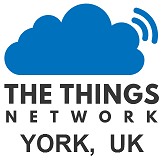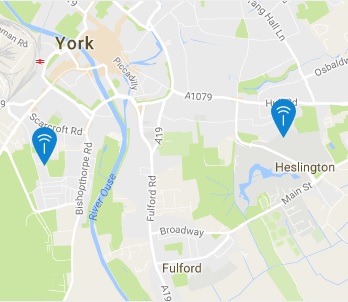ttnyork
Building a low power, wide area, IoT network for the City of York

What's this all about?
We're aiming to build a low powered network that covers the City of York and enables smart sensors to connect to the "internet of things". These sensors could be river level sensors like those used on the Oxford flood network, they could be pet trackers with built in GPS, soil PH level sensors in fields, boat trackers on the Ouse...the list goes on. All these devices have one things in common and that is the need for a way to transmit data to an application that can process and act on it - that is where ttnyork comes in.
What is an LPWAN?
A Low Power Wide Area Network (LPWAN) is basically a fancy way of describing a wireless network that enables devices to send and receive data from the internet over many thousands of metres using very little power. Currently, if you wanted to deploy a river level sensor, you would either have to connect it with wires or use WiFi/Cellular technology. This would require quite large batteries or solar panels due to the power levels needed for these types of wireless. With an LPWAN it is possible to design sensors that run for many years on standard, off-the-shelf batteries. ttnyork is built using a flavour of LPWAN called LoraWan. LoraWan is named after the proprietary LongRange wireless system designed by Semtech.
An LPWAN is made up of a number of gateways - these are fixed devices that connect to the internet and also have a radio transmitter and receiver through which they can talk to any sensors in range. A gateway relays messages between nodes and applications that can use their data, they can typically cover a radius of 1-2km in city environments (exact range depends on a number of factors including location, terrain, interference, etc). The more gateways a network has the more reliable and wide reaching it will be; if you have enough gateways you can also do interesting things using triangulation to pinpoint where nodes are transmitting from. A gateway can cost between £200 and £1500 which varies based on make and model. The two gateways currently deployed in York were built from parts to keeps the costs low. The Things Network have built and are about to start shipping an indoor gateway which brings simplicity and performance at a reasonable price point. York will need somewhere between 10-15 gateways to provide complete coverage.
Which parts of York are covered?
There are currently two gateways covering parts of York around the University of York campus (National STEM Learning Centre) and the South Bank/Millenium bridge areas. Both gateways are capable of supporting many hundreds of sensor nodes. The York Hackspace should also be in range.
We'd like to extend this coverage to include all areas within the outer ring road which will require more gateways and support/funding.

Getting involved
There's lots to be done and we'd like to build a community of volunteers and businesses who are passionate about seeing this succeed.
As a local business/organisation you can contribute to the network through buying or sponsoring a new gateway, we're happy to work with you to set it up - or we can do it all on your behalf if you'd prefer.
As a local "maker" or someone with an interest in electronics and technology you could build some sensors or work on an app to visualise sensor data.
If you have an interest in marketing or digital comms you could help with this website (it really needs it!) or simply tweet about the cause.
There are lots of ways to get involved, these are just some examples, if you're keen to help out but don't know how best to start then get in touch and say Hi.
Using the network
Anyone can use ttnyork, you simply need to sign up for an account on the things network and begin building or deploying your sensors! If your sensors are mobile then you'll find networks popping up in lots of locations around the UK and beyond!
You can buy off the shelf kits, fully developed sensors or roll your own using the many tutorials available on the internet.